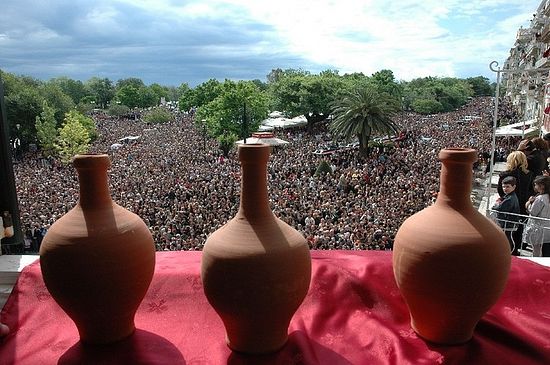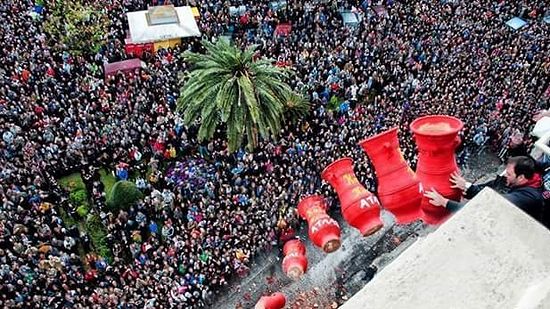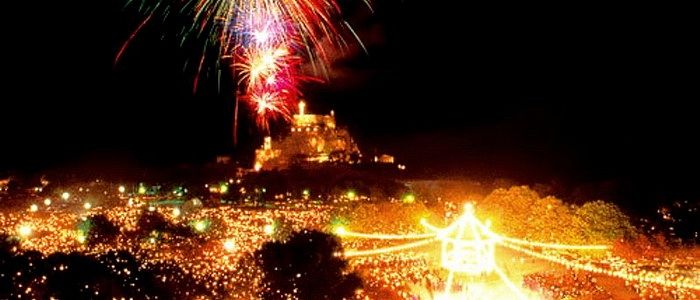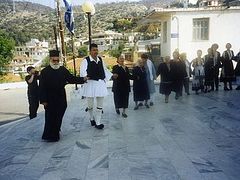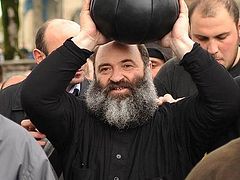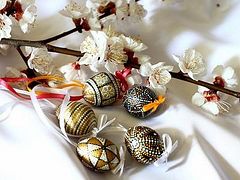We would like to familiarize our readers with the traditions and characteristic features of the observance of Holy Week and Pascha in Corfu. The Resurrection of Christ—the feast of feasts—is celebrated boisterously and with great pomp there. You will find information about all of this in the translation of an article from Kerkyrain.gr that we offer below.
Pascha, the greatest feast of the Orthodox Church, is celebrated all over Greece with a special devotion. On the island of Corfu (Kerkyra) Paschal celebrations have their distinctive features. Western European influence on the way this Orthodox feast is observed there strikes your eye.
Corfu residents call Pascha “Lambri Lambria”—literally “the brightness of brightnesses”, thus stressing this day’s radiant joy. After seven weeks of strict fasting and abstaining from all kinds of pleasures, comes the bright day—the day of joy and the first meal after fast.
Local peculiar customs and a direct link between these holy days and the onset of spring emphasize the uniqueness of Paschal festivities on Corfu, which attracts multitudes of visitors from all over the world. Another local peculiarity is the touching polyphonic Church music that resounds through the island and flows out of churches into streets and suburbs of Kerkyra (also Corfu), the capital city of Corfu. This harmonious singing, the so-called four-part harmony, which was brought here from Crete in the seventeenth century, is still called “the Cretan chant”.
Paschal festivities on this island begin on Palm Sunday, or “Wayone”, as this feast is commonly referred to on Corfu. At eleven in the morning the cross procession walks from St. Spyridon’s Church. It has been held annually since 1630 in commemoration of a famous miracle—the deliverance of the island from the devastating plague that killed many Corfu residents in 1629. The procession travels a long route, walking around the imaginary line of the city walls of the time of the Venetian domination; it makes several stops for quick prayer services, bypassing the Jewish neighborhood, as it did before. This procession is also unique for the fact that it gathers all eighteen philharmonic orchestras of Corfu that come to honor the memory of the island’s heavenly patron—St. Spyridon of Tremithus. After the procession these orchestras march through the city’s historic center, playing joyous marches. At nine in the evening a concert of the “Mantzaros” Philharmonic Society of Corfu begins at the Municipal Theater, whose melodies tune the audience to the special mood of Holy Week.
On Holy Monday, Corfu residents do their shopping for Pascha. The air is filled with the fragrance of traditional sweet dishes, namely fogatsa (sweet bread), mandola (caramelized roasted almonds), and colombina (Corfu Christmas cake). In the evening bells invite the faithful to church, and crowds of believers gather to listen to the words of the Gospel: Woe unto you, scribes and Pharisees, hypocrites (Mt. 23:13).
The hymn of St. Cassiani is sung in churches on Holy Tuesday, and in the evening the Society of Corfiot Festivals organizes the “From Golgotha to the Resurrection” poetry and music night near the Old Palace’s columns.
In olden times, Sarocco Square would be filled with bleating lambs on Holy Week. They would be brought from villages and sold to traders from Patras and residents of Corfu. Towards the evening the city churches are packed with worshippers who come to participate in the sacrament of Holy Unction, and at half past eight in the evening a multitude of people gather at the Municipal Theater to listen to a concert of the Municipal Chorus, which performs church music and chants of Holy Week. Thus people are involved in the drama of Holy Week through listening to both the Western and Eastern church music.
On Holy and Great Thursday, the Service of the Twelve Passion Gospels is held. In the villages the women make braids of white cotton cloth with knitting needles during this service, temporarily stopping their braiding while the Gospels are read. Twelve candles are lit in the Duomo, the cathedral of the local Roman Catholic diocese, and are put out successively after the reading of each of the Gospels. Additionally, after the first strike of the bell on Holy Thursday eggs are painted red—a color that symbolizes the regeneration of life and nature.
On Holy and Great Friday churches are gradually crowded with the faithful till noon. They come for the Service of the Deposition of Christ from the Cross and vesting Him in the snow-white linen burial cloth—in an stirring atmosphere, to the sounds of a funeral bell. Thereafter children scamper about in search of flowers for the Shroud. The Holy Shroud is almost always decorated by young women. By the middle of the day the Shrouds are displayed for veneration.
In the second half of the day on Holy and Great Friday, the procession of “the Epitaphia” (that is, “Shrouds”) begins in the Old City’s picturesque streets and squares. In suburbs the processions walk their own routes in local areas. From midday (from two p.m. in some places) till late in the evening dozens of “Epitaphia” are carried in processions accompanied by the singing of the words from the Lamentation Service: “Every generation, O my Christ, offers praises at Thy burial”. With the onset of the evening, all the processions meet in the city’s historic center. First the processions come out from the Church of the Theotokos “Spiliotissa”, from the New Venetian Fortress, and the Church of Christ the Pantokrator in Cambiello district, then they are joined by all other churches, and at ten in the evening the event concludes with a procession of the “Epitaphion” (Shroud) from the cathedral. Each “Epitaphion” is accompanied by a church choir, a local orchestra, and people carrying special large candles (“tortses”), Venetian-style lanterns (“manualia”), banners and flags that come out reversed on that evening as a sign of mourning. School students, members of scout organizations, girls with baskets full of bright flowers (which bloom abundantly in Corfu at this season) participate in these processions.
In the evening at Muraya, the destination of the procession from the cathedral, candles are placed onto small candlesticks at intervals—they are lit during the procession so that they form a long, luminous line. The procession of the cathedral’s Shroud, in which the city clergy and authorities, along with the philharmonic orchestra, singers and thousands of other participants take part, gives this sad day a new perspective. The “old” (dressed in red garments) philharmonic orchestra performs The Adagio by Tomaso Albinoni, the “Mantzaros” orchestra (in blue) plays Marcia Funebre by Giuseppe Verdi, and the Philharmonic Union of Corfu, “Kapodistrias”, performs the sad piece, Suentura, by Angelo Mariani as well as the Funeral March by Frederic Chopin.
At six in the morning on Holy and Great Saturday an artificial earthquake is made at the Church of the Theotokos of Xenon in accordance with a local custom. It is done after the reading of the Epistles, re-enacting the real earthquake that occurred after the glorious Resurrection of Christ.
At nine in the morning of Holy and Great Saturday a solemn procession around St. Spyridon’s Church is arranged. In 1574, Venetians prohibited the procession of the “Epitaphion” (Shroud) on Holy Friday “for safety reasons”, but allowed the St. Spyridon processions on Holy Saturday. Thus, since that time residents of Kerkyra have annually walked in the cross procession with St. Spyridon’s relics, during which the holy hierarch is glorified as the city’s bishop, and the Shroud is carried behind it. It is one of the oldest and most impressive processions in honor of St. Spyridon. This custom was established in the 1550s in the memory of a miracle of St. Spyridon, who saved Kerkyra’s population from starvation. The procession moves to the rhythm of the sad music, played by the city’s three philharmonic orchestras.
By tradition the “old” orchestra plays the sad opera Amleto (“Hamlet”) by the Italian composer Franco Faccio, which is followed by the funeral march Calde Lacrime (“Hot Tears”) by the Italian composer Giuseppe Micheli played by the “Mantzaros” orchestra, and in conclusion the funeral march from Ludvig Beethoven’s symphony “Eroica” (“Heroic”) is performed by the “Kapodistrias” orchestra. After the end of the procession, St. Spyridon’s relics are displayed for veneration until Bright Tuesday.
At eleven in the morning on Holy Saturday, people wait for the so-called “First Resurrection”. When the service is over, the cathedral bells begin to ring merrily, and residents hurl thousands of clay jugs and pots filled with water from their windows, which crash very noisily below. This custom is probably based on the line from the Holy Scriptures: Thou shalt dash them in pieces like a potter's vessel (Ps. 2:9).1 It actually came from Venetians, who used to throw away old objects from their windows on the New Year’s Eve so that the New Year could bring them new things. Corfu residents adopted this custom and changed the date to Pascha, replacing old objects with clay jugs and pots (“botides”). According to another version, this custom has pagan roots. Pascha falls on the beginning of a new natural “death-and-rebirth cycle”. Nature awakens from its winter sleep, and new fruit is collected into new containers, while old containers are thrown away. After smashing the pots orchestras parade through the city streets, playing the joyous march: “Don’t Be Afraid, Greeks!”
On that day Israelites from the once-large Jewish community out of fear would lock themselves up in the Jewish neighborhood (“Ovriaki”); and the island’s village churches on hearing the toll of the bells of the capital’s churches would join in and spread it further, while each farmer would slaughter a lamb and use its blood to “paint” three crosses on his entrance door.
In the meantime in Pinya, the capital’s ancient marketplace, the Society of Corfiot Festivals organizes the “Etimo tis Mastelas”—that is, “the Rite of Beer Barrel”. The so-called “fakini” (urban porters) and “pinyadori” (local inhabitants) assemble inside the old market in Pinya and place a wooden cask half filled with water in the middle of the street. They decorate the cask with green myrtles, greenery and ribbons, and go to different directions, asking passers-by to drop coins into the cask “for luck”. Formerly, at the time of “the First Resurrection” the “pinyadori”, who were scattered around the square, would chase after a passer-by to catch and throw him into the cask. The “victim” would splash everybody around him with water, while the orchestras were parading through the streets. At last the “bather” would scramble out of the cask, holding the coins collected from the bottom of the cask and laughing cheerfully.
In the evening of Holy and Great Saturday, the Catholic service for the feast of the Resurrection of Christ is celebrated at the Duomo Catholic Cathedral to the accompaniment of the organ. It ends about eleven in the evening to ensure that everybody has time to attend the Orthodox Paschal service.
The Paschal service is celebrated in the Upper Square. The procession of the cross comes out of the nearby Church of St. Parasceva, with the metropolitan, the municipal authorities, philharmonic orchestras and thousands of worshippers involved in it. It is a breathtaking spectacle: all the windows and balconies of six-storied houses around the square are open, with candles burning on them, while the square itself is lit up with the light of thousands of votive lamps in the hands of the faithful who come to celebrate Pascha in the biggest square of Greece.
Paschal celebrations take place with music, Bengal lights, and fireworks. As soon as the service is over, the orchestras parade around the city and play joyous marches, and people join them and sing. Festivities are held through the night till the morning, accompanied by the traditional Greek cuisine: Paschal tsilihurda soup (a local variety of the Greek magiritsa), colored eggs, fogatsa (sweet bread), colombas (dove-shaped cakes that came from Venice), and wine in large quantities. The island is illuminated with lights that symbolize the end of fasting and the Resurrection of Christ.
At seven in the morning on Paschal Sunday each church holds the cross procession (like the procession of the Epitaphion) through the city streets, with orchestras, school students, members of scout organizations and choirs participating. From 11.30 a.m. the Naval Base of Corfu, following an ancient custom, hosts joyous Paschal celebrations with traditional dances and a variety of snacks at the New Fortress. Unlike the rest of Greece, roasting Paschal lamb on a spit is still a novelty in Corfu and is not a part of local traditions. On Pascha the Corfiots normally eat egg and lemon soup (avgolemono), made with two or three different kinds of meat, reserving lamb for Bright Monday. This is because the stomach grows weak after a prolonged fasting, and soup soothes it.
Agape Vespers (also called the Vespers of Love) is celebrated in the evening of Paschal Sunday, when the priest greets the congregation in church, and they kiss the Gospel and the priest’s hand in return. At six in the evening the procession with an icon of the Resurrection is held at the Garitsa Bay; and the joint cross procession with an icon of the Resurrection of Christ and the “Dimosiana” icon of the Holy Theotokos is arranged in Potamos [a large village suburb of Corfu Town/Kerkyra c. 2.5 miles North of it.—Trans.]. Thus one of the most ancient cross processions in Corfu, the “Potamos” five-week procession, begins.
In the past, groups of singers would go from house to house in the evening, singing Paschal folk songs: “We sing the Resurrection and glorify God, and we all adore our Master Christ.”
In the morning of Bright Monday (which they call “Nya Devtera”) virtually all villages of Corfu arrange cross processions that last from one to three hours. People walk through their own villages or proceed to neighboring settlements where they make stops for performing prayer services, venerating the shrines, and laying flowers for the Mother of God and the Risen Christ.
At five in the evening of Bright Tuesday the ceremony of the return of St. Spyridon’s relics into his cathedral is conducted. After being displayed by the entrance to the cathedral from Holy and Great Friday they are laid back into their shrine located inside the cathedral.
The first week of the celebration of Pascha in Corfu concludes with the feast in honor of the icon of the Holy Theotokos “the Life-Giving Spring”, which is kept at Paleokastritsa Monastery. By tradition, Bright Friday is considered the first summer holiday in Corfu.

